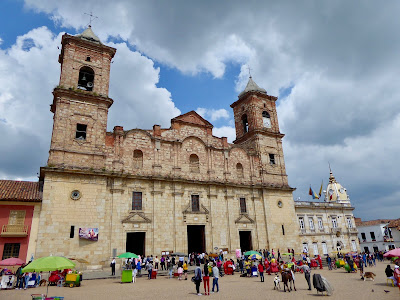I’d heard of Poland’s Wieliczka Salt Mine cathedral and, as long as travel bans are lifted by the end of June, I plan to visit it as part of a summer trip to Russia, Estonia, Latvia, Lithuania and Poland. (Editor's Note: the European trip has been cancelled due to COVID-19.)
But until I started researching for the trip to Colombia I took this past December, I was unaware of the Catedral de Sal de Zipaquira.
Zipaquira is a city of 130,000 people located just 50 kilometres northeast of the Colombian capital of Bogota, though with the heavy traffic in the metropolis of eight million people it took a couple of hours to get there by van. A tourist train also runs between the two cities.
While Zipaquira has lovely colonial architecture and has gained local notoriety for its boarding school where Nobel Prize in Literature winner Gabriel Garcia Marquez studied during his teen years (and which is now open to visitors to showcase his time there), it’s best known for the Roman Catholic church built within its tunnels 200 metres underground.
While the Salt Cathedral isn’t officially recognized by the Catholic Church as a cathedral because it doesn’t have a bishop, it holds regular services and is a functioning church in addition to being a tourist attraction.
Salt had been mined from the site for centuries before more modern techniques were introduced in the 20th century to extract it more efficiently. Work on the original cathedral began in the early 1930s and expanded in 1950. It was officially inaugurated in 1954.
However, since the cathedral was carved out of an active mine, structural problems and safety concerns arose that led to it being closed in 1992. Work began on another cathedral by making additions to caves created by previous mining operations, and it was inaugurated in 1995.
Upon entering, after paying a U.S. $17.65 admission fee for a one-hour guided tour in English, visitors can stop at 14 small chapels representing the stations of the cross — which illustrate the events of Jesus’ final journey before he was crucified.
After reaching the entrance ramp to The Dome, there’s a balcony offering views of a bas relief of a large cross. You then descend further to get a closer look and to see three interconnected naves.
After taking in the cathedral, the site offers other attractions to lengthen your stay. I watched a 15-minute 3D film about the mine and sat through an eight-minute sound and light show that made me think of a low-budget version of Las Vegas’ Fremont Street Experience. I passed on the virtual reality room and gift shops, but walked by a few small exhibits and through a simulated emerald mine since the mineral is quite prominent in Colombia.
Upon returning to the surface and bright sunlight, visitors can also walk through a small maze, take a short zipline ride or check out the Brine Museum to learn more about the extraction process on the grounds of Salt Park.






No comments:
Post a Comment